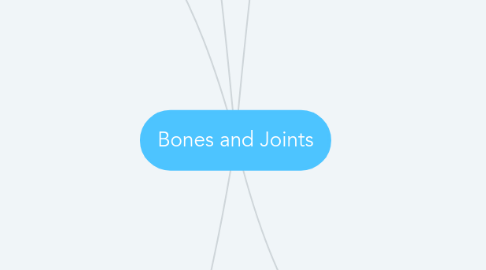
1. Fibrous Joints
1.1. Suture
1.1.1. A tight union between two or more bones in a skull of an adult
1.1.2. No movement
1.1.3. Example: sagital suture, lamboidal suture, and coronal suture
1.1.4. Fontanelles
1.1.4.1. "Soft spots" in an infants skull
1.1.4.2. A membrane between cranial bones before they come together completely
1.2. Syndesmosis
1.2.1. In this joint bones are close together but not touching
1.2.2. Bones are held together by collagen fibers
1.2.3. Little to no movement
1.2.4. Example: distal tibio-fibular joint and radius-ulna joint
1.3. Gomphosis
1.3.1. Where the tooth meets the mandible and maxillae
1.3.1.1. Connected by perioclontal ligaments
1.3.1.2. Immovable
1.3.2. Fibrous joint made up of peg and socket
2. Cartilaginous Joints
2.1. Synchondroses
2.1.1. Epiphyseal plate
2.1.2. Connects first rib and manubrium
2.1.3. Contains hyaline cartilage
2.1.4. Permits growth of bone but not movement
2.1.5. Replaced by bone when large bone stops growth (a few are still present in adults)
2.1.6. Immovable
2.1.7. Example: sternoclavicular joint
2.2. Symphyses
2.2.1. In this joint two bones are covered by a thin layer of hyaline cartilage
2.2.2. Presence of a disk of fibro-cartilage between two bones that acts as a shock absorber
2.2.3. Intervertebral joints
2.2.4. Slightly movable
2.2.5. Example: pubis symphysis
3. Synovial Joints
3.1. Makes up most of our permanent joints
3.2. All of these joints allow greatest range of movement
3.2.1. The end of bone at articulation is covered with smooth hyaline cartilage
3.2.2. The joint is lubricated by thick fluid called synovial fluid
3.3. The joint is covered by flexible articular capsule
3.4. Joint capsule
3.4.1. Outer:
3.4.1.1. dense irregular connective tissue
3.4.1.2. Continuous with periosteum
3.4.2. Inner:
3.4.2.1. Areolar connective tissue
3.4.2.2. Synovial membrane
3.4.2.3. Produces and secretes synovial fluid that fills the joint cavity
3.4.2.4. Slippery, reduces friction and nourish the articular cartilage
3.5. Menisci
3.5.1. Cushions
3.5.2. Deepens the joint
3.5.3. Makes bones fit together better
3.6. Temporomandibular joint
3.6.1. Has extra cartilage to divide joint cavity
3.6.2. Provides more movement
3.6.3. Bursa(e)
3.6.3.1. A fibrous sac filled with synovial fluid and it rolls
3.6.3.2. Found between skin and bone, muscle and bone, ligament and bone, or tendon and bone
3.6.4. Tendon Sheath
3.6.4.1. Wraps "like a hot dog bun" around tendons
3.6.4.2. Located in various places including wrists and ankles
3.7. Examples
3.7.1. Hinge joint
3.7.1.1. The convex surface of one bone fits on concave surface of other bone
3.7.1.1.1. This permits uniaxial movement
3.7.1.2. Example: knee joint, elbow joint, ankle joint
3.7.2. Pivot joint
3.7.2.1. Composed of central bony pivot surrounded by a collar made partly of bone and partly of ligament
3.7.2.2. Movement of pivot joint is uniaxial and is able to rotate around a central axis
3.7.2.3. Example: atlantoaxial joint between atlas and axis
3.7.3. Condyloid joint
3.7.3.1. Modifications of ball and socket joints
3.7.3.2. Movement is biaxial because of ligaments and muscles
3.7.3.3. Example: metacarpophalangeal joint of fingers (except thumb)
3.7.4. Gliding joint
3.7.4.1. Always small and formed by flat articular surface so that one bone slides on another bone
3.7.4.2. Movement is multiaxial
3.7.4.3. Example: articular process of vertebrae, clavicular joint
3.7.5. Saddle Joint
3.7.5.1. Both bones at articulation are shaped like a saddle
3.7.5.2. Bones have both concave and convex area at right angle to each other
3.7.5.3. Example: carpometacarpal joint of thumb
3.7.6. Ball and socket joint
3.7.6.1. Composed of globe like head of one bone that fits into a cup like cavity on another bone
3.7.6.2. Most freely movable joint of all joints
3.7.6.3. Movement is multiaxial
3.7.6.4. Example: shoulder and hip joints
4. Components of Long Bones
4.1. Epiphysis
4.1.1. The head of the bone
4.2. Diaphysis
4.2.1. The shaft of the bone
4.3. Articular Cartilage
4.3.1. Type of cartilage is hyaline
4.3.2. Covers the end of the epiphysis
4.4. Spongy bone
4.4.1. This area is porous
4.4.2. Bone tissue is filled with red bone marrow
4.4.3. Important for producing blood cells
4.4.4. Found in the ends of long bones
4.5. Periosteum
4.5.1. Outer layer
4.5.1.1. Made of dense irregular connective tissue
4.5.1.2. Is used for protection
4.5.1.3. An attachment place for ligaments
4.5.2. Inner layer
4.5.2.1. Made of osteogenic tissue
4.5.2.2. Capable of generating new bone
4.5.3. Is a membrane that covers the outer surface, except at the joints of long bones
4.5.4. Located
4.6. Compact bone
4.6.1. Any part of the actual bone that isn't spongy bone
4.6.2. Not porous
4.7. Medullary cavity
4.7.1. Also known as the marrow cavity
4.7.2. Central cavity of bone shafts
4.7.3. Where red bone marrow and/or yellow bone marrow are stored
4.8. Endosteum
4.8.1. Covers the inside of bones
4.8.2. Surrounds the medullary cavity
4.8.3. Thin vascular membrane of connective tissue
4.9. Perforating fibers
4.9.1. Connects periosteum to compact bone
4.9.2. Bundles of strong collagenous fibers
4.10. Nutrient blood vessels
4.10.1. Enters shaft through the nutrient foramen
4.10.2. Runs through the cortex
4.10.3. Divides into ascending and descending branches in the medullary cavity
4.10.4. Supplies to the meduallary cavity, inner two-thirds of cortex, and metaphysis
4.11. Epiphyseal Plate
4.11.1. Also known as the epiphyseal line
4.11.2. Where the epiphysis and metaphysis meet
4.11.3. Responsible for the lengthwise growth of long bone
4.11.4. After epiphyseal fusion happens the bone can no longer grow
4.11.5. A cartilaginous plate
5. Types of Bone Cells
5.1. Osteogenic stem cells
5.1.1. Found in the stratum basal in the epidermis
5.1.2. when it reproduces it creates a stem cell and an osteoblast
5.1.3. Found in endosteum and periosteum
5.1.4. Function: to produce osteoblasts
5.2. Osteoblasts
5.2.1. Create bone extra cellular matrix
5.2.2. Hardens with the addition of minerals
5.3. Osteocytes
5.3.1. Maintain bone health
5.4. Osteoclast
5.4.1. Multinucleate
5.4.2. Formed from several leukocytes
5.4.3. Have microvilli
5.4.3.1. There for secretion of enzymes that break down bone tissue
5.4.3.1.1. This liberates (frees) calcium and phosphorus
5.4.3.1.2. These two things then go into the blood stream
5.4.4. They are mobile
5.4.5. Found in endosteum and periosteum
